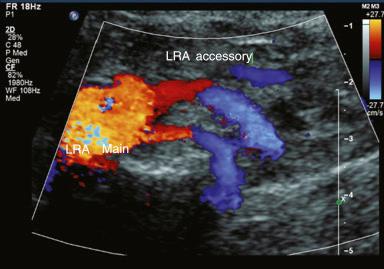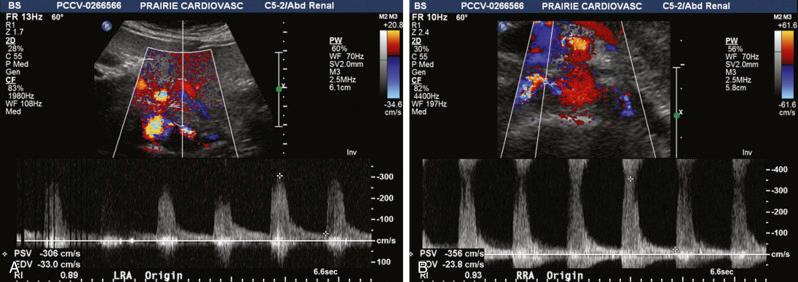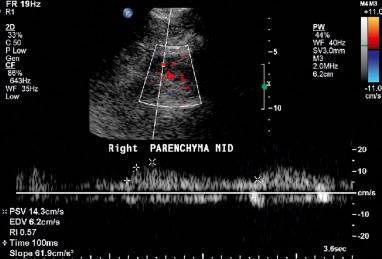Physical Address
304 North Cardinal St.
Dorchester Center, MA 02124
Renal artery stenosis (RAS) is caused by a heterogeneous group of diseases with various causes, clinical manifestations, courses, treatments, and outcomes. Atherosclerotic renal artery sclerosis and fibromuscular dysplasia are the most common causes of renal artery sclerosis.
Patients in whom atherosclerosis is progressive may have signs and symptoms of chronic ischemic renal disease, resulting in renovascular hypertension and renal dysfunction. However, the causal relationship between RAS, hypertension, and renal dysfunction is difficult to prove.
Duplex Doppler ultrasonography, when performed noninvasively in a high-volume, experienced vascular laboratory, is an excellent diagnostic tool and ideal for surveillance. The specificity and sensitivity of ultrasound are competitive with computed tomography angiography and magnetic resonance angiography, but ultrasound has a lower cost.
Renal arteriography remains the “gold standard” for the diagnosis of atherosclerotic renal artery sclerosis, allowing full definition of the perirenal abdominal aorta and assessment of the diameter and contour of the renal artery and its branch vessels. However, angiographic evaluation of the severity of atherosclerosis (i.e., percent diameter stenosis) alone may be inadequate in establishing the cause and effect between atherosclerotic renal artery sclerosis and hypertension or renal dysfunction.
The Cardiovascular Outcomes in Renal Atherosclerotic Lesions (CORAL) study demonstrated that renal artery stenting does not confer a significant benefit for the prevention of clinical events when added to comprehensive, multifactorial medical therapy in people with RAS and hypertension or kidney disease.
Accepted consensus indications for renal artery revascularization include severe, refractory hypertension; recurrent pulmonary edema; and progressive renal insufficiency despite optimal medical therapy. However, these recommendations are based on limited supporting clinical trial evidence.
Percutaneous revascularization with newly released large diameter coronary drug-eluting stents represents a new advantageous option (off label) for renal artery revascularization with appropriate clinical indications. The clinical effectiveness and safety of adjunctive renal endovascular technologies (i.e., distal protection devices) and medications (i.e., glycoprotein IIb/IIIa inhibitors) have not been established in robust clinical trials.
Percutaneous radiofrequency renal sympathetic denervation is safe, but its efficacy has not been demonstrated in a randomized, blinded, sham-controlled study.
We recognize Drs. Rocha-Singh, Mishkel, and Kolluri for their contribution to the prior edition of this chapter.
Atherosclerotic renal artery stenosis (ARAS) is associated with chronic renal ischemia and increased cardiovascular morbidity and mortality. The primary aim of renal revascularization therapies is to improve blood pressure control, salvage renal function, and reduce cardiovascular risk. Although technical advances in the endovascular treatment of ARAS have improved dramatically in the past decade, allowing patients with more extensive ARAS to be considered for revascularization, the indications for treating these patients remain controversial and highlight the major divergence in practice among physicians regarding the appropriate treatment for patients with ARAS. Small and large prospective, randomized clinical trials from Europe have failed to demonstrate the clinical benefit of renal revascularization in reducing cardiovascular events or poor renal outcomes compared with medical therapy alone. Determining the essential role of renal revascularization and appropriate patient selection has become the central issue among physicians. Consensus regarding the technical aspects of renal stent revascularization has reached a general level of acceptance among interventionists.
The emergence of percutaneous renal sympathetic denervation as a safe and effective technology in the treatment of drug-resistant hypertensive patients has highlighted the important role of the sympathetic nervous system in hypertension. Ongoing large clinical trials in the treatment of hypertension and renal insufficiency in these patient populations, with and without ARAS, will ensure that renal interventional therapies for hypertension control will remain an exciting area of clinical research.
ARAS is the most common secondary cause of hypertension. Left untreated, it may progress to renal dysfunction. The prevalence of end-stage renal disease in the United States is 372,407 patients per year, with approximately 100,000 new cases diagnosed each year ; 2.1% of these new cases are attributed to ARAS. ARAS is reported in 0.5% to 5% of all hypertensive patients and 45% of patients with severe or malignant hypertension.
The prevalence of ARAS increases with age, especially in patients with diabetes, hypertension, coronary artery disease (CAD), or aortoiliac occlusive disease. A population-based study reported a prevalence of renal artery stenosis (RAS) (>60% stenosis) to be 6.8% among patients older than age 65.
In a Mayo Clinic series, more than 19% of patients with CAD and hypertension were found to have greater than 50% stenosis of the renal arteries. In another series, more than 14% of patients with peripheral artery disease (PAD) were found to have significant angiographic stenosis of the renal arteries. The risk factors for the development of ARAS are similar to those of CAD. Similarly, stroke and PAD are highly prevalent among patients with end-stage renal disease on hemodialysis. ARAS is progressive in 36% to 71% of patients with this condition, and 39% of patients with greater than 75% ARAS progress to complete occlusion within the 3-year follow-up. In a prospective study of 84 patients with at least one abnormal renal artery, progression of RAS occurred at a rate of approximately 20% per year. Unfortunately, it is difficult to identify the subset of patients who will progress to renal failure.
Although 90% of renal artery lesions are atherosclerotic, the remaining 10% result from other causes. Fibromuscular dysplasia (FMD), the second most common cause of RAS, results in fibrous thickening of the intima, media, or adventitia of the arterial wall. FMD is more common among women between the ages of 15 and 50 years and is recognized by its beaded appearance on angiography. Less common causes include trauma, dissection, external compression by a tumor or mass, thromboemboli, renal artery aneurysms, neurofibromatosis, vasculitis, retroperitoneal fibrosis, and radiation-induced stenosis.
The renal vasculature is richly innervated by sympathetic afferent and efferent nerve fibers that control renovascular resistance and the resultant increase in renin release. Efferent renal nerve activity is controlled by several inputs, such as aortic and carotid baroreflexes and cardiac stretch receptors. Renal nerves often receive greater sympathetic activation than others, especially in the setting of essential hypertension. This disproportionate increase in renal sympathetic activity results in increased renovascular resistance and increased plasma renin activity, and it promotes the retention of sodium and water. The afferent renal nerves contribute to the pathogenesis of renovascular hypertension by increasing activation of the sympathetic nervous system.
In unilateral ARAS, decreased blood flow through the affected kidney results in increased production of renin, which cleaves angiotensin to produce angiotensin I, which is converted to angiotensin II. Angiotensin II is a direct vasoconstrictor that stimulates aldosterone secretion and results in sodium reabsorption. The retained salt and water are then excreted by the unaffected kidney, producing a renin-dependent hypertensive state. In bilateral ARAS or ARAS in a solitary functioning kidney without the ability to sense an elevated blood pressure, pressure natriuresis does not occur, resulting in volume expansion and suppression of renin activity. These patients become highly dependent on angiotensin II for glomerular filtration. Angiotensin II maintains the efferent arteriolar tone of the glomeruli. When angiotensin-converting enzyme inhibitors (ACEIs) or angiotensin receptor blockers (ARBs) are administered, the efferent arteriolar tone is no longer maintained, and glomerular filtration is decreased, resulting in renal insufficiency. Sodium restriction and diuresis convert bilateral RAS to a renin-mediated form of hypertension.
Duplex ultrasound, computed tomography angiography (CTA), and magnetic resonance angiography (MRA) are contemporary noninvasive imaging modalities used to diagnose RAS. Other tests can be used to assess the potential physiologic effect of RAS.
Duplex ultrasonography is a useful noninvasive test to screen for RAS, with sensitivity between 75% and 98% and specificity between 87% and 100%. Its sensitivity in identifying accessory renal arteries is 67% ( Fig. 42.1 ). Duplex ultrasonography can produce images of the renal arteries, assess blood flow velocity and pressure waveforms, and measure kidney size without contrast or radiation exposure ( Figs. 42.2 and 42.3 ). Estimation of renal artery percent diameter stenosis is based on the renal artery velocity and the ratio of renal artery to aortic velocity ( Table 42.1 ), and antihypertensive medications do not interfere with duplex imagining. It can also provide information regarding renal parenchymal disease, tumors, and calculi. It is less expensive than CTA or MRA, can be used for renal artery stenting surveillance, and can be easily performed at the patient’s bedside. Unfortunately, early studies of this technology reported a 10% to 20% rate of failure due to operator inexperience, patient obesity, or bowel gas. The test may be time consuming when done by inexperienced technologists.



| Degree of Stenosis (%) | Duplex Criteria |
|---|---|
| 0–59 | RAR <3.5 and renal artery PSV <200 cm/s |
| 60–99 | RAR ≥3.5 or renal artery PSV >200 cm/s (and flow turbulence) |
| Occluded | Absence of arterial flow and low-amplitude signal |
The renal resistive index (RI) is a commonly used measure of resistance to arterial flow within the renal vascular bed. It is calculated during duplex ultrasonography (see Fig. 42.3 ).
Become a Clinical Tree membership for Full access and enjoy Unlimited articles
If you are a member. Log in here